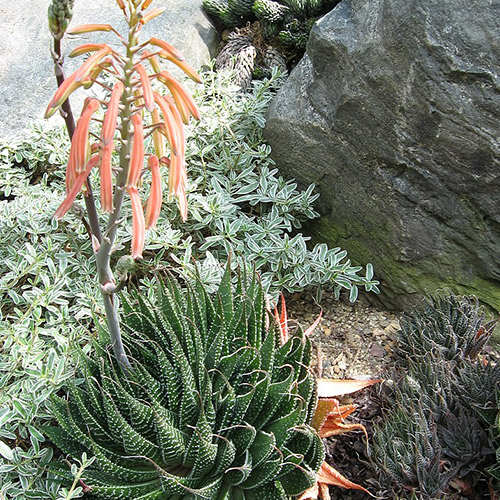📷 Chhe, wikipedia.org
Aristaloe aristata aka Lace Aloe
Succulents | Updated: February 15, 2025
This frost-hardy Aloe has leaves that mimic a Haworthia. Unlike some Aloes, this one is particularly fast growing. The dark green leaves have white bumps on them, are wide at the bottom and taper into a sharper point at the top. It has pink flowers that attract bees and hummingbirds.
Quick Guide
- Partial sun to partial shade ⛅
- Typical water needs for a succulent
- Plant grows up to 8″ (20 cm) tall
- Plant grows up to 6″ (15 cm) wide
- Zone 8a (Minimum 10° F | -12.2° C)
- Cold hardy to 0°F
- Propagation by offsets
- Generally non-toxic to humans and animals
- Actively grows in Winter
How to 🩷 Care for and Propagate Your 🪴 Succulents
General Care for Aristaloe aristata aka Lace Aloe
Aristaloe aristata, or Lace Aloe, is a stellar choice for a miniature garden. This succulent grows rapidly, forming clumps of rosettes. Look out for its charming pink blossoms in the summer – they’re a magnet for birds and bees!
Watering
Aristaloe aristata follows typical succulent watering needs but is a bit touchy about over-watering. Stick to the soak and dry method, letting the soil dry out completely between waterings.
Where to Plant
Lace Aloe isn’t frost-hardy, so if your area gets colder than 0°F (-17.7°C), plant it in a container you can move indoors. It thrives in partial sun to partial shade.
For indoor planting, place it in a sunny room – near a south-facing window if you’re in the Northern Hemisphere.
How to Propagate Aristaloe aristata aka Lace Aloe
Lace Aloe is great at propagating. You’ll see lots of offsets sprouting around its base. Just pull these up and let them dry for a day or two before replanting.
Previously Known As
A little fun fact: this plant was previously known as Aloe aristata.
Tags & Attributes
Scientific Classification
Kingdom: Plantae
Clade: Tracheophytes
Clade: Angiosperms
Clade: Monocots
Order: Asparagales
Family: Asphodelaceae
Subfamily: Asphodeloideae
Tribe: Aloeae
Genus: Aristaloe
Species: A. aristata



